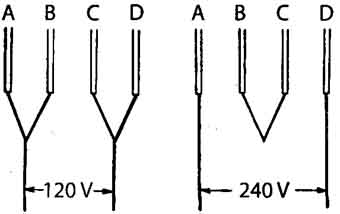Choose the type of motor that is suitable for the job and the available power source. Described here are common ac motors. Features to consider are size, starting capacity, initial cost, operating cost, and ease of maintenance.
The direction of rotation can be changed on ac motors. On a repulsion-induction motor, shift the position of the brushes. On other types of ac motors, reverse two of the wires coming from the inside of the motor. If the motor must be reversed often, a special reversing switch can be installed for the purpose.
Single-phase motors
The motors most commonly found in homes and on farms are called single-phase motors because they operate on the usual 120/240- volt, single-phase current. They are not usually available in sizes larger than 7 1/2 hp although a few larger ones are made. The three types described in this discussion operate only on single-phase AC.
Larger single-phase motors are often dual-voltage, meaning they are designed to be operated at either of two voltages, For example 120 or 240 volts. The motor has four leads. Connected one way the motor operates at 120 volts; connected the other way it operates at 240 volts. See diag. below.

Above Diag.: By reconnecting the leads, the motor can be used on
either 120 or 240 volts.
If there is a choice, always operate your motor at the higher voltage. At 240 volts it will consume only half as many amperes as at 120 volts. With any given wire size the voltage drop will be only one-fourth as great (measured as a percentage) on the higher voltage than it would be on the lower voltage.
Split-phase motors
This is a simple type of motor, which makes it relatively trouble-free; there are no brushes, no commutator. It’s available only in sizes of ‘A hp and smaller. It draws a very heavy amperage while starting. Once up to full speed, the split-phase motor develops just as much power as any other type of motor, but it’s not able to start heavy loads. Therefore don’t use it to drive any machine that is hard to start, such as a deep-well pump, or an air compressor that has to start against compression. Use it on any machine that is easy to start, or on one where the load is thrown on after the machine is up to full speed. It’s entirely suitable for washing machines, grinders, saws and lathes, and general utility use.
Capacitor motors
This is similar to the split-phase type, with the addition of a capacitor or a condenser that enables it to start much harder loads. There are several grades of capacitor-type motors available, ranging from the home-work shop type which starts loads from 1 1/2 to 2 times as heavy as the split-phase, to the heavy-duty type which will start almost any type of load. Capacitor motors usually are more efficient than split-phase, using fewer watts per horsepower. The amperage consumed while starting is usually less than half that of the split-phase type. Capacitor motors are commonly used only in sizes up to 10 hp.
Repulsion-induction motors
This type of motor, properly called the “repulsion start, induction run” motor, is commonly called a repulsion-induction or R-I motor. Available in sizes up to 10 hp, it has a very high starting capacity and should be used for heavier jobs -- it will “break loose” almost any kind of hard-starting machine. The starting current is the lowest of all the single-phase types of motors. These motors have a commutator connected to the windings on the rotor which allows for precise positioning of the rotor poles (by moving the brush positions) in relation to the field poles to produce maximum starting torque. Commutators and brushes require skilled maintenance. With the increased availability of three-phase power, use of RI motors is decreasing.
Three-phase motors
These motors are the simplest and most trouble-free type made and, as the name implies, operate only on three-phase ac. Three-phase motors in sizes 1/2 hp and larger cost less than any other type, so use them if you have three-phase current available. Don’t assume because you have a three-wire service that you have three-phase current; more likely you have three-wire, 120/ 240-volt, single-phase current. If in doubt, consult your power supplier.